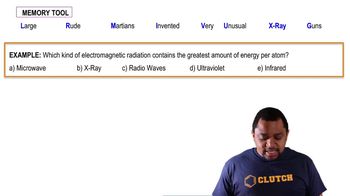If you put 120 volts of electricity through a pickle, the pickle will smoke and start glowing orange-yellow. The light is emitted because sodium ions in the pickle become excited; their return to the ground state results in light emission. b. What is the energy of 1.00 mol of these photons? (A mole of photons is called an Einstein.)
Is the observation that UV-B radiation is a more important cause of sunburn in humans than UV-A radiation consistent with the answer to part (c)?
 Verified step by step guidance
Verified step by step guidanceKey Concepts
Types of UV Radiation

Mechanism of Sunburn

Photoprotection and Sunscreen
Certain elements emit light of a specific wavelength when they are burned or heated in a non-luminous flame. Historically, chemists used such emission wavelengths to determine whether specific elements were present in a sample. Some characteristic wavelengths for a few of the elements are given in the following table:
Ag 328.1 nm Fe 372.0 nm
Au 267.6 nm K 404.7 nm
Ba 455.4 nm Mg 285.2 nm
Ca 422.7 nm Na 589.6 nm
Cu 324.8 nm Ni 341.5 nm
(c) When burned, a sample of an unknown substance is found to emit light of frequency 6.58 * 1014 s-1. Which of these elements is probably in the sample?
In August 2011, the Juno spacecraft was launched from Earth with the mission of orbiting Jupiter, arriving nearly five years later in July of 2016. The distance between the two planets varies depending on where each planet is in its orbit, but at the closest, the distance between Jupiter and Earth is 391 million miles. What is the minimum amount of time it takes for a transmitted signal from Juno to reach the Earth?
The watt is the derived SI unit of power, the measure of energy per unit time: 1 W=1 J/s. A semiconductor laser in a CD player has an output wavelength of 780 nm and a power level of 0.10 mW. How many photons strike the CD surface during the playing of a CD 69 minutes in length?
In an experiment to study the photoelectric effect, a scientist measures the kinetic energy of ejected electrons as a function of the frequency of radiation hitting a metal surface. She obtains the following plot. The point labeled 'n0' corresponds to light with a wavelength of 542 nm. (a) What is the value of n0 in s - 1?
Consider a transition in which the electron of a hydrogen atom is excited from n = 1 to n = ∞. (a) What is the end result of this transition?
